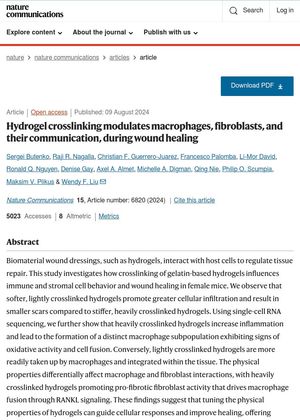TLDR Softer hydrogels help wounds heal better with less scarring.
The study investigates how varying the crosslinking density of GelMA hydrogels affects wound healing in murine skin wounds by modulating macrophage and fibroblast behavior. Lightly crosslinked GelMA (lo-GelMA) promotes better cellular integration, reduced inflammation, and smaller scar sizes, while highly crosslinked GelMA (hi-GelMA) induces stronger inflammatory responses and larger scars. The findings suggest that softer, more porous hydrogels (lo-GelMA) are more beneficial for wound healing by reducing fibrosis and promoting tissue repair, highlighting the importance of hydrogel properties in designing effective wound dressings.
 66 citations
,
May 2021 in “Science Advances”
66 citations
,
May 2021 in “Science Advances” Different scaffold patterns improve wound healing and immune response in mouse skin, with aligned patterns being particularly effective.
328 citations
,
November 2020 in “Nature Materials” Hydrogel scaffolds can help wounds heal better and grow hair.
January 2025 in “Pharmaceuticals” Peptide-based hydrogels are promising for healing chronic wounds effectively.
37 citations
,
February 2024 in “Military Medical Research” Biomaterials can help heal wounds without scars and regenerate skin features.
 8 citations
,
June 2022 in “International Journal of Molecular Sciences”
8 citations
,
June 2022 in “International Journal of Molecular Sciences” Tiny particles called extracellular vesicles show promise for skin improvement and anti-aging in facial care but face challenges like low production and lack of research.
 1 citations
,
February 2024 in “Journal of nanobiotechnology”
1 citations
,
February 2024 in “Journal of nanobiotechnology” Hydrogels combined with extracellular vesicles and 3D bioprinting improve wound healing.

The new hydrogel helps heal burn wounds better than current options by reducing bacteria and inflammation.





